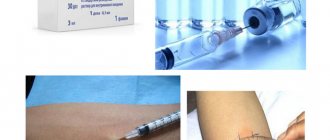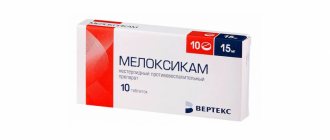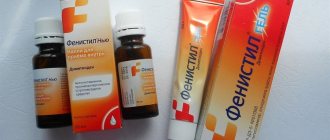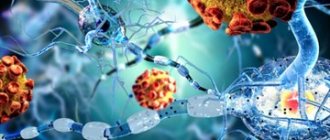Medicine Cocarnit
The Egyptian company EIPICo once released Cocarnit, which has the ability to improve metabolism. The metabolic drug helps the regeneration of peripheral nerve fibers.
What is metabolism? This is a chemical reaction necessary for the vital support of the entire organism. If this process is disrupted, your health immediately worsens, your body weight increases, and general weakness and other negative conditions may appear. To normalize metabolism, you need to lead an active lifestyle and not eat excess food. In addition, Cocarnit is prescribed to restore metabolism.
Compound
The medication is packaged in glass ampoules, the powder is colored pink. There is a special liquid solution for diluting it.
Pharmacodynamics
Cocarnit is a vitamin complex that helps improve metabolism. The medicine has analgesic and neurometabolic properties that have a positive effect on the emotional and vegetative state. The drug owes its properties to its components.
| Substance | Description |
| Nicotinamide | The component of the drug can affect the metabolism of carbohydrates and nitrogen. The substance also takes part in the processes of oxidation and reduction and helps transport ATP into cells. Has sedative properties. Thanks to these properties, the drug is used to treat depression and mental disorders. Relieves anxiety. |
| Cocarboxylase | A coenzyme that plays an important role in the metabolic process of carbohydrates. Takes part in the synthesis of nucleic acid. Helps with glucose absorption. |
| Adenosine triphosphate | This component is a derivative of adenosine and an energy substrate for cells. It actively promotes the normalization of metabolism. The substance enters the cell membrane with the help of nicotinamide. It has vasodilating and hypotensive properties. |
| Cyanocobalamin | This constituent substance of the drug takes part in the synthesis and accumulation process of proteins, in the metabolic process of fats and carbohydrates. As a result, the patient's cholesterol level decreases. |
Interactions with drugs
The manufacturer of the drug Cocarnit itself, and doctors do not recommend taking it together with other medications. This is due to the fact that unwanted reactions of the body may occur.
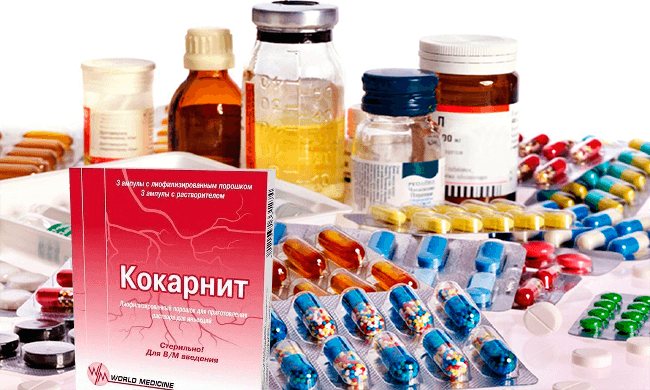
- If the drug is taken in combination with diuretics, there may be a possibility of an increase in the level of potassium in the circulatory system;
- When taking the drug Cocarnit together with glycosides, there is a risk of aggravating symptoms of cardiovascular diseases;
- If a one-time dose of Pethidine, Quinidine with the drug Cocarnit is prescribed, this may cause a decrease in the dosage of Lidocaine in the blood plasma, instead of the prescribed administered dose;
- If it is taken together with morphine, it can cause difficulty breathing;
- Combination with an anticoagulant can lead to bleeding;
- When taken together with an inhibitor, it can significantly reduce blood pressure;
- Xanthinol reduces the effectiveness of Cocarnit, so it is not recommended to take them together.
Indications for use of Cocarnit
Doctors prescribe the drug Cocarnit in the following cases:
- inflammation in the heart muscle;
- paralysis or muscle pain;
- nervous inflammatory pathologies;
- ischemic disease;
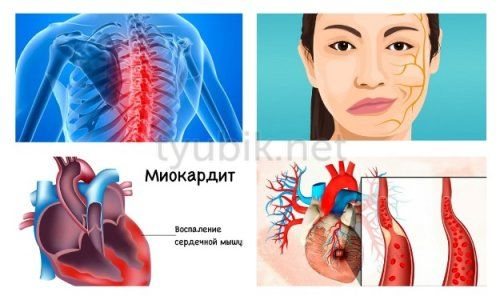
- radiculitis;
- lumbago;
- neuritis and neuropathies;
- diabetic polyneuropathy.
It is prohibited to give Cocarnit injections without indications for use. Symptomatic treatment is prescribed by your attending physician; injections are not given without his recommendation. They are used exclusively intramuscularly: first of all, Cocarnit injections help against pain and inflammation in muscle tissue, so they are often prescribed for muscle pain.
[media=
https://youtu.be/K_Y1-otMKvs
]
In the instructions of Cocarnita
The medicine Cocarnit is used only when injections are prescribed by a doctor. The injections must be administered by a person with at least minimal medical knowledge of human anatomy.

Indications for taking the drug
A list of diseases for which a doctor may prescribe treatment with Cocarnit. For example:
- Neuritis and neuralgic diseases of any origin;
- Pain in the spinal region with radiculitis, lumbago;
- Bursitis, myalgia;
- Myocarditis, stroke.
Popular There will be no pain or arrhythmia after injection with Lidocaine
This remedy is not particularly indicated for pregnant women. In case of urgent need, it is taken with caution, as there may be a significant risk to the unborn child.
Contraindications
Cocarnit has many positive reviews, but despite this, not all patients can take it. A list of cases in which injections are strictly prohibited.
- If you observe a decrease in heart rate in a patient;
- For heart failure;
- In case of stroke or heart attack;
- If the patient suffers from bronchial asthma;
- A tumor was discovered;
- Stomach diseases, ulcerative colitis;
- Low/high blood sugar levels.
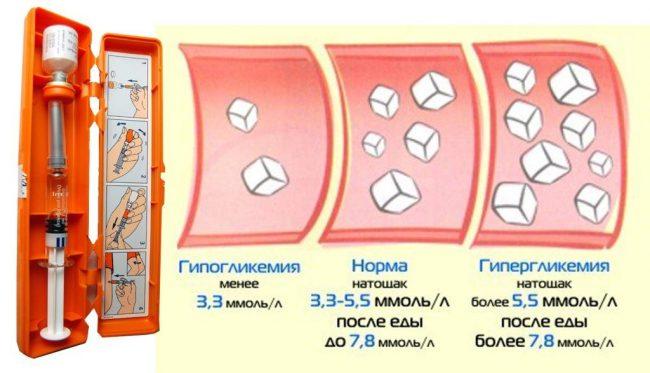
Features of application
The package along with Cocarnit injections contains an anesthetic auxiliary substance - lidocaine. After the powder substance is dissolved with water, you also need to draw lidocaine into the syringe. But first you need to make sure that the patient does not have an allergic reaction to this drug. If the answer is yes, then Cocarnit should be replaced with another medicine.
If the patient has an allergy, then swelling, red rashes all over the body are detected, breathing becomes more frequent or health becomes worse. Allergies are dangerous because they can cause anaphylactic shock, which can lead to death.
Cocarnit should be administered strictly intramuscularly. Open the glass ampoule with the dry substance and the solution liquid, mix thoroughly until a homogeneous liquid is formed, and then draw up a sterile syringe. The injection site must be wiped with a disinfectant, such as alcohol. Then it is very slowly injected into the gluteal muscle. This is necessary so that seals do not form in the fat layer.
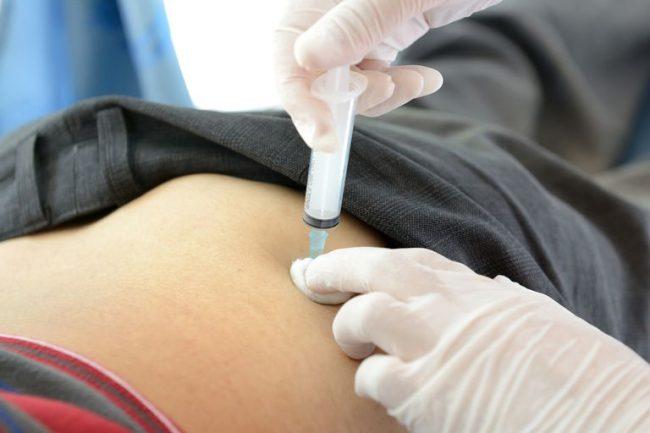
The daily dosage is 4 ml: administer one ampoule of the medicine in the morning and evening. To eliminate symptoms, you will need to undergo a treatment course for 7-9 days. If there is no improvement during this period, the doctor prescribes stronger drugs.
Cocarnit (liof.d/sol. i.m. 187.125 amp. 2ml No. 3+sol.)
A country
Egypt
The country of production may vary depending on the batch of goods. Please check with the operator for detailed information when confirming your order.
Compound
1 ampoule contains: triphosadenine disodium trihydrate 10 mg, cocarboxylase 50 mg, cyanocobalamin 0.5 mg, nicotinamide 20 mg.
Excipients: glycine - 105.875 mg, methyl parahydroxybenzoate - 0.6 mg, propyl parahydroxybenzoate - 0.15 mg. Solvent: lidocaine hydrochloride - 10 mg, water for injection - up to 2 ml. Lyophilisate for preparing a solution for intramuscular administration in the form of a pink lyophilized mass. The reconstituted solution is transparent and pink in color.
pharmachologic effect
The drug is a rationally selected complex of metabolic substances and vitamins. Trifosadenine is an adenosine derivative that stimulates metabolic processes. Has a vasodilating effect, incl. to the coronary and cerebral arteries. Improves metabolism and energy supply to tissues. Has hypotensive and antiarrhythmic effects. Under the influence of ATP, blood pressure decreases, smooth muscles relax, and the conduction of nerve impulses improves. Cocarboxylase is a coenzyme formed in the body from thiamine (vitamin B1) supplied from outside. It is part of the carboxylase enzyme, which catalyzes the carboxylation and decarboxylation of β-keto acids. Indirectly promotes the synthesis of nucleic acids, proteins and lipids. Reduces the concentration of lactic and pyruvic acids in the body and promotes the absorption of glucose. Improves trophism of nervous tissue. Cyanocobalamin (vitamin B12) is converted into methylcobalamin and 5-deoxyadenosylcobalamin in the body. Methylcobalamin is involved in the conversion of homocysteine to methionine and S-adenosylmethionine - key reactions in the metabolism of pyrimidine and purine bases (hence DNA and RNA). If there is insufficiency of the vitamin in this reaction, it can be replaced by methyltetrahydrofolic acid, and folate-requiring metabolic reactions are disrupted. 5-deoxyadenosylcobalamin serves as a cofactor in the isomerization of L-methylmalonyl-CoA to succinyl-CoA, an important reaction in carbohydrate and lipid metabolism. Vitamin B12 deficiency leads to impaired proliferation of rapidly dividing cells of hematopoietic tissue and epithelium, as well as impaired formation of the myelin sheath of neurons. Nicotinamide is one of the forms of vitamin PP, participates in redox processes in the cell, improves carbohydrate and nitrogen metabolism, and regulates tissue respiration.
Indications for use
Symptomatic treatment of diabetic polyneuropathy.
Mode of application
The drug is injected deep IM (into the gluteal muscle). In cases of severe pain, it is advisable to start treatment with intramuscular administration of 2 ml (1 amp.)/day until acute symptoms subside. Duration of use: 9 days. After improvement of symptoms or in cases of moderately severe symptoms of polyneuropathy, 2 ml (1 amp.) is prescribed 2-3 times a week for 2-3 weeks. The recommended course of treatment is 3-9 injections depending on the severity of the disease. The duration of treatment and repeated courses are determined by the doctor depending on the nature and severity of the disease.
Interaction
In patients using hypoglycemic agents of the biguanide group (metformin), due to impaired absorption of cyanocobalamin from the gastrointestinal tract, a decrease in the concentration of cyanocobalamin in the blood may be observed. Drug interactions with other hypoglycemic agents have not been described. Cyanocobalamin is not compatible with ascorbic acid, heavy metal salts, thiamine, thiamine bromide, pyridoxine, riboflavin, folic acid. Cyanocobalamin should not be used simultaneously with drugs that increase blood clotting. In addition, concomitant use of cyanocobalamin with chloramphenicol should be avoided. Aminoglycosides, salicylates, antiepileptic drugs, colchicine, potassium preparations reduce the absorption of cyanocobalamin. When combined with drugs containing triphosadenine and dipyridamole, the effect of dipyridamole is enhanced, in particular its vasodilating effect. Dimiridamol enhances the effect of triphosadenine. Some antagonism appears when the drug is used together with purine derivatives (caffeine, theophylline). It should not be administered simultaneously with cardiac glycosides in large doses, as the risk of adverse reactions from the cardiovascular system increases. When used simultaneously with xanthinol nicotinate, the effect of the drug is reduced. Nicotinamide potentiates the effect of sedatives, tranquilizers, and antihypertensive drugs.
Side effect
The frequency of adverse reactions is given in accordance with the WHO classification: very often (more than 1/10); often (less than 1/10, but more than 1/100); uncommon (less than 1/100, but more than 1/1000); rare (less than 1/1000, but more than 1/10,000); very rare (less than 1/10,000), including isolated cases; frequency unknown. From the immune system: rarely - allergic reactions (skin rash, difficulty breathing, anaphylactic shock, Quincke's edema). From the nervous system: very rarely - dizziness, headache, agitation, confusion. From the cardiovascular system: - very rarely - tachycardia; - in some cases, bradycardia, arrhythmia; — frequency unknown — pain in the heart area, redness of the skin of the face and upper half of the body with a tingling and burning sensation, “hot flashes.” From the gastrointestinal tract: very rarely - vomiting, diarrhea. From the skin and subcutaneous tissues: very rarely - increased sweating, acne, itching, urticaria. From the side of musculoskeletal and connective tissue: very rarely - convulsions. General disorders and disorders at the injection site: very rarely - irritation, pain and burning at the injection site, weakness may occur. If any of these adverse reactions worsen or any other adverse reactions not listed in the instructions appear, the patient should inform the doctor. If severe adverse reactions develop, the drug is discontinued.
Contraindications
- hypersensitivity to any component of the drug or solvent; - cardiovascular diseases (acute heart failure, acute myocardial infarction, uncontrolled arterial hypertension, arterial hypotension, severe forms of bradyarrhythmias, AV block II-III degree, chronic heart failure (III-IV functional class according to NYHA), cardiogenic shock and others types of shock, QT prolongation syndrome, thromboembolism, hemorrhagic stroke); - inflammatory lung diseases, COPD, bronchial asthma; - pregnancy; - period of breastfeeding; — age up to 18 years; - hypercoagulation (including in acute thrombosis), erythremia, erythrocytosis; - peptic ulcer of the stomach or duodenum in the acute phase; - gout; - hepatitis, cirrhosis of the liver. The drug should be used with caution for angina pectoris.
Overdose
The components of the drug Cocarnit have a wide therapeutic range. Symptoms Trifosadenine. Exceeding the maximum daily dose (about 600 mg for an adult) can lead to the development of the following symptoms: dizziness, decreased blood pressure, short-term loss of consciousness, arrhythmia, AV block of the second and third degrees, asystole, bronchospasm, ventricular disorders, sinus bradycardia and tachycardia. Cocarboxylase. The following symptoms have been reported after administration of more than 100 times the recommended dose: headache, muscle spasm, muscle weakness, paralysis, arrhythmia. Cyanocobalamin. After parenteral administration of a high dose, eczematous skin disorders and benign acne were observed. When used in high doses, hypercoagulation and disruption of purine metabolism may develop. Nicotinamide. When used in large doses, hyperpigmentation, jaundice, amblyopia, weakness, and exacerbation of gastric and duodenal ulcers were observed. With long-term use, the development of steatohepatosis, an increase in the concentration of uric acid in the blood, and impaired glucose tolerance were noted. Treatment Administration of the drug is stopped immediately, symptomatic therapy is prescribed, incl. desensitizing.
special instructions
If the symptoms of the disease worsen or there is no effect after 9 days, it is necessary to correct the course of treatment. When using the drug Cocarnit, proper selection of the dose of the hypoglycemic drug and adequate control of the course of diabetes mellitus are necessary. The color of the prepared solution should be pink. Do not use the drug if the color of the solution has changed. The solution must be used immediately after its preparation. Use in pediatrics There are no data on the effectiveness and safety of the drug Cocarnit in children. Impact on the ability to drive vehicles and operate machinery If side effects from the central nervous system (dizziness, confusion) occur, it is recommended to refrain from driving vehicles and other mechanisms.
Dispensing conditions in pharmacies
On prescription
Important instructions
- After the dry contents of the glass ampoule have been diluted with liquid, the medicine should be immediately administered to the patient into the gluteal muscle. It is impossible to store the finished drug for a long time, as the effectiveness of the active substances of the drug may significantly decrease;
- The finished injection liquid should be pinkish or reddish in color. If the prepared medicinal substance has a predominant color color, then the patient is strictly prohibited from giving such an injection;
- Only a member of the medical staff should administer the medicine.
Before administering the medicine to the patient, it is necessary to treat the site where the injection is intended to be given with a disinfectant. The drug is used with caution:
- If the patient has difficulty hearing or has an irregular heart rhythm;
- After any surgical operation;
- If alkaloids are detected in the patient's bloodstream;
- For diseases of the respiratory system;
- If there are problems with the kidneys or liver;
- If the patient regularly has high blood pressure.

Using Cocarnit when observing at least one of the points can subsequently lead to serious health complications. If the medicine is used for a long time, it may contribute to the development of chronic liver diseases.
Material and methods
A clinical and neurophysiological examination was carried out on 30 patients with DDSP aged from 27 to 65 years (average - 55.3±10.8 years) and duration of diabetes from 2 to 20 years (average - 8.0±5.8 years). Inclusion criteria
into the study: patients of both sexes over the age of 18 years, suffering from DDSP, who signed informed consent.
Exclusion criteria
: contraindications in accordance with the instructions for use of Cocarnit; polyneuropathy of another origin; taking alpha-lipoic acid, preparations containing B vitamins, and Actovegin for a month before inclusion in the study.
All patients underwent a standard neurological examination with a detailed assessment of pain using the PainDetect pain questionnaire. TSS questionnaires.
.: Total Symptom Score - overall assessment of neuropathy symptoms) and NSS (
English
: Neurological Symptoms Score - assessment of neurological symptoms).
The assessment of quality of life was carried out using the Russian version of the general international questionnaire EuroQol-5D ( English
: European Quality of Life instrument - European Quality of Life Assessment Tool).
In order to study the state of the peripheral neuromotor apparatus, patients underwent stimulation electromyography (EMG) with analysis of conduction along the motor fibers of the peripheral nerves, along the sensory fibers of the peripheral nerves and evoked cutaneous sympathetic potential (ESP). The study was carried out on a 2-channel electromyograph Keypoint Portable (Denmark) using surface lead and stimulating electrodes. The condition of the motor fibers of the median, ulnar, tibial and peroneal nerves was assessed. The amplitude of the motor response (M-response) and the threshold for its registration, the velocity of propagation of excitation (SPV), distal latency (DL) and the state of late responses were analyzed. The following were accepted as the norm: the amplitude of the M-response of the ulnar nerve - no less than 6 mV, the median and tibial nerves - no less than 4 mV, the peroneal nerve - no less than 3 mV; SRV along the motor fibers of the peripheral nerves of the upper extremities - not lower than 50 m/s, of the lower extremities - not lower than 40 m/s; DL for the median and ulnar nerves is 3.5 ms, for the peroneal and tibial nerves – 4 ms [6, 7].
Conduction along sensory fibers was studied on the median, ulnar, sural and superficial peroneal nerves. The SRT and sensory response amplitude (S-response) were determined. The S-response amplitude for the median and ulnar nerves was considered normal to be at least 10 μV, for the sural and superficial peroneal nerves to be at least 5 μV; SRT along the sensory fibers of the peripheral nerves of the upper extremities is not less than 48 m/s, of the lower extremities - not less than 38 m/s [8, 9].
To study the state of autonomic fibers, the amplitude and latency of VCSPs were studied. The amplitude of the VCSP from the palmar surface of the hand was taken to be no lower than 330±102 μV, the latent period was 1.4±0.1 s; from the plantar surface of the foot—amplitude 230.2±81.7 μV, latent period—2.0±0.2 s [10, 11]. Clinical and neurophysiological examination was carried out twice - before drug administration and 2 weeks after the last injection. Cocarnit was injected deeply intramuscularly into the gluteal muscle, 2 ml once daily for 9 days.
Statistical processing of the obtained results was carried out on a PC using Excel Worksheet software from the Microsoft Office 2013 package. The method of variation statistics was used with the calculation of the arithmetic mean ( M
), standard deviation (
SD
), and significance test (
t
).
p
were accepted as significant .
Overdose and consequences
The manufacturer's instructions state that it is not recommended to exceed the dosage to avoid consequences. Don’t think that the more you drink, the faster you will recover. On the contrary, in this case it can only get worse.
Popular Complex therapy for toxins with rheopolyglucin droppers
Primary symptoms of overdose when consuming an excessive dose of Cocarnit.
- Excessive headache may suddenly occur and your head may become dizzy;
- The patient gets tired quickly and may even lose consciousness;
- Swelling in the lungs;
- Asphyxia;
- Blood pressure drops sharply;
- Coma.
If the patient experiences at least one of the points after taking an excessive dose of the drug, then it is necessary to stop taking the drug. It would be logical to call an ambulance.
Storage features and cost
Cocarnit is produced by several manufacturing companies. This factor significantly affects the pricing of the drug. If you buy the medicine in injections, then for three ampoules in glass you can pay 720-750 rubles. The drug is sold in pharmacy kiosks as prescribed by a doctor.

According to the instructions, it should be stored without exposure to daylight. Children's access to medicine should be limited. If the storage conditions are not properly met, Cocarnit will become unusable and will need to be disposed of, since the use of an unusable or expired drug is strictly prohibited. The shelf life of the medicine is three years.
Kokarnit's analogs
Cocarboxylase
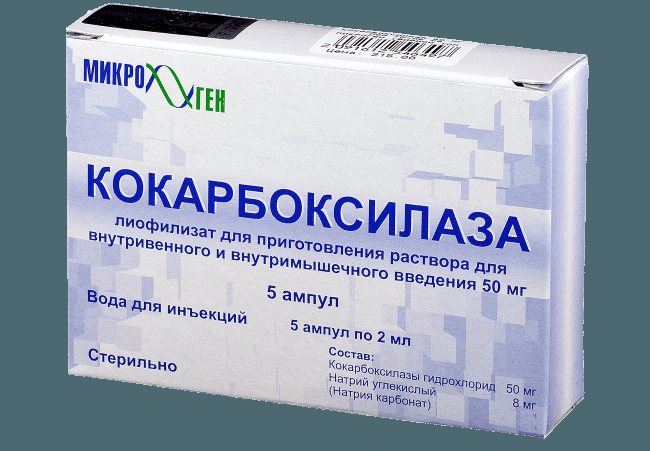
Available in glass bottles with a dosage of 50 mg. The constituent substances have the ability to increase access to cells of essential nutrients and oxygen. This improves energy metabolism and inhibits lactic acid. The active substances of the drug do not allow metabolic acidosis to occur. They help relax muscle tissue, resulting in reduced pulsation.
The drug Cocarboxylase is most often prescribed for heart diseases in the compensation stage, for diseases of a nervous nature, and for ketoacidosis in diabetes mellitus. In cases where there is insufficiency of cerebral blood flow.
The medicine is used for drug intoxication and for the treatment of infectious diseases. When using this medicine, the patient may have an allergy in the form of redness or rashes. There is a possibility of disruption of the gastrointestinal tract, decreased blood pressure, and bradycardia.
Korilip
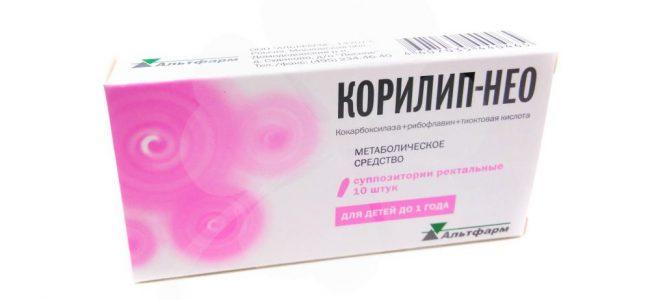
Rectal suppositories Korilip are a Russian analogue of the drug Cocarnit. It contains the active substance - cocarboxylase, as well as auxiliary components: lipoic acid, vitamins and minerals. Helps improve the metabolic process, helps eliminate acidosis and hypoxia. Due to the properties of the substances, proteins and nucleic acids are formed, and the liver tissue is protected.
The medicine Korilip is indicated for use in diseases where oxygen starvation occurs. It is prescribed to patients suffering from chronic heart disease, infectious diseases, drug poisoning, and ketoacidosis. Also indicated for use in children.
Symptoms of adverse events after using the drug are rare. For example, an allergic rash, coughing, and sneezing may occur. Dyspeptic reactions include a gag reflex and nausea. Do not take the drug if you are intolerant to at least one of the active substances.
Cocarnit in ampoules: features of the drug
Cocarnit means injections in ampoules. Available only in lyophilisate format for solution for injection. Not available in tablet, suspension or other forms. It contains metabolic vitamins and substances that help speed up metabolism.
The action of the drug includes:
- activation of oxidative processes in the body;
- improvement of nitrogen metabolism;
- antiallergic effects;
- reduction of atherogenic lipoproteins in the blood;
- vasodilation;

- decreased blood pressure;
- reducing the likelihood of developing arrhythmia;
- positive effects on liver function;
- improving the functioning of the nervous system.
The medicine looks like a pinkish powder; it will need to be diluted for injection. The solvent for the powder comes complete with the drug in one package.
You should not try to dilute Cocarnit powder with “improvised” means - strictly follow the instructions, use the solvent suggested by the manufacturer of the drug.
Indications for the use of Cocarnit in ampoules are varied. Metabolic support is required for various diseases and during recovery processes in the body.
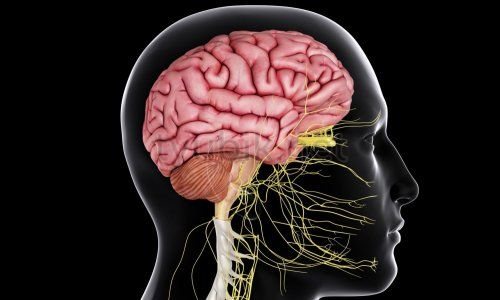
If it is necessary to stimulate metabolism, your doctor may prescribe Cocarnit. You cannot “prescribe” it for yourself.
How do you feel about mandatory vaccination?
- Positively, it prevents many diseases. 60%, 2641 votes
2641 votes 60%2641 votes - 60% of all votes
- Negatively, these are all government schemes to make it easier to manage us. 26%, 1157 votes
1157 votes 26%
1157 votes - 26% of all votes
- Neutral, I don’t think it has any effect on my health. 13%, 592 votes
592 votes 13%
592 votes - 13% of all votes
Total votes: 4390
Votes: 4365
January 17, 2018
×
You or from your IP have already voted.


